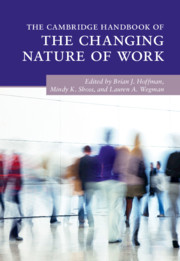Book contents
- The Cambridge Handbook of the Changing Nature of Work
- The Cambridge Handbook of the Changing Nature of Work
- Copyright page
- Contents
- Figures
- Tables
- Contributors
- Part I Introduction to the Changing Nature of Work
- Part II What Has Changed?
- Part III Implications for Talent Management and Impact on Employees
- 14 Implications of the Changing Nature of Work for Selection
- 15 Implications of the Changing Nature of Work for Recruitment and Retention
- 16 Performance Management and the Changing Nature of Work
- 17 Implications of the Changing Nature of Work for Training
- 18 Leader Behaviors and the Changing Nature of Work
- 19 The Changing Nature of Teams
- 20 Managing Employees across the Working Lifespan
- 21 Implications of the Changing Nature of Work for Employee Attitudes and Work Perceptions
- 22 Implications of the Changing Nature of Work for the Interface between Work and Nonwork Roles
- 23 Implications of the Changing Nature of Work for Employee Health and Safety
- 24 The Dark Side of Workplace Technology
- 25 Implications of the Changing Nature of Work for the Employee–Organization Relationship
- 26 The Future of Work
- 27 Sustainability as a Driver of Organizational Change
- Index
- References
22 - Implications of the Changing Nature of Work for the Interface between Work and Nonwork Roles
from Part III - Implications for Talent Management and Impact on Employees
Published online by Cambridge University Press: 02 April 2020
- The Cambridge Handbook of the Changing Nature of Work
- The Cambridge Handbook of the Changing Nature of Work
- Copyright page
- Contents
- Figures
- Tables
- Contributors
- Part I Introduction to the Changing Nature of Work
- Part II What Has Changed?
- Part III Implications for Talent Management and Impact on Employees
- 14 Implications of the Changing Nature of Work for Selection
- 15 Implications of the Changing Nature of Work for Recruitment and Retention
- 16 Performance Management and the Changing Nature of Work
- 17 Implications of the Changing Nature of Work for Training
- 18 Leader Behaviors and the Changing Nature of Work
- 19 The Changing Nature of Teams
- 20 Managing Employees across the Working Lifespan
- 21 Implications of the Changing Nature of Work for Employee Attitudes and Work Perceptions
- 22 Implications of the Changing Nature of Work for the Interface between Work and Nonwork Roles
- 23 Implications of the Changing Nature of Work for Employee Health and Safety
- 24 The Dark Side of Workplace Technology
- 25 Implications of the Changing Nature of Work for the Employee–Organization Relationship
- 26 The Future of Work
- 27 Sustainability as a Driver of Organizational Change
- Index
- References
Summary
The changing nature of work has produced a variety of work demands or stressors (e.g., job insecurity, financial instability, unpredictability of work schedules) that can interfere with life outside of work, and has also provided significant resources to some employees in the form of flexibility in the scheduling and location of work, enhanced levels of autonomy or discretion on the job, and exposure to different cultures. Managing the demands and capitalizing on the resources require employees to make proactive work–nonwork decisions that take all important facets of their life into account. The effectiveness of work–nonwork decisions is often dependent on the support that individuals and their families receive from the organizations for which they work and the societies in which they live.
Keywords
- Type
- Chapter
- Information
- The Cambridge Handbook of the Changing Nature of Work , pp. 467 - 488Publisher: Cambridge University PressPrint publication year: 2020
References
- 3
- Cited by



